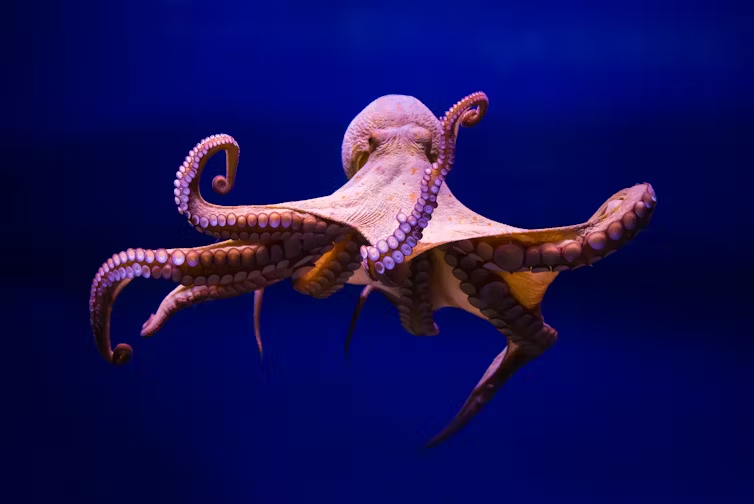Introduction
Octopuses are some of the most fascinating creatures in the ocean. Among their many incredible features, their tentacles or more accurately, arms stand out as true biological marvels. Each of their eight limbs can act on its own, thanks to a network of neurons spread throughout. These limbs aren’t just for movement they’re also for feeling, tasting, hunting, and solving problems. In this article, we’ll explore the mind-blowing capabilities of octopus tentacles, from their anatomy to their role in future technology.
Key Facts About Octopus Tentacles
| Feature | Description |
|---|---|
| Number of limbs | 8 arms (not technically “tentacles”) |
| Length | Up to 1 meter (3.3 feet), depending on species |
| Suction cups | Up to 240 per arm, can grip and taste simultaneously |
| Neural capacity | Over 500 million neurons; 2/3 located in the arms |
| Regeneration | Yes – can regrow lost limbs completely |
| Muscle structure | No bones, uses hydrostatic pressure for movement |
| Independent control | Each arm can think and act semi-independently |
| Use in research | Studied in soft robotics, prosthetics, and neuroscience |
What Makes Octopus Tentacles So Unique?
They’re Not Actually Tentacles
Let’s clarify a common myth: octopuses don’t have “tentacles.” They have arms.
- Tentacles (like those of squids) are usually longer and have suckers only at the end.
- Octopus arms have suckers along the entire length.
In short, octopuses have eight arms, not tentacles.
Built Without Bones
Octopus limbs contain no bones at all. Instead, they rely on a hydrostatic skeleton.
This means:
- Arms are filled with muscles and fluid.
- They can twist, elongate, and bend in any direction.
That’s why octopuses can squeeze through tiny cracks and mimic almost any shape.
Neural Intelligence in Each Arm
Distributed Brain Power
An octopus has around 500 million neurons.
- Only 1/3 of these are in the central brain.
- The rest are in the arms.
This gives each limb some decision-making power.
For example, an arm can explore, feel, and even react to threats without instructions from the brain.
Self-Sufficient Limbs
In experiments, scientists observed detached octopus arms reacting to stimuli.
- They could move, grab objects, and even try to feed.
This level of autonomy is rare in the animal kingdom.
Suction Cups That Can Taste
Each octopus arm has hundreds of suction cups. In the common octopus (Octopus vulgaris), each arm can have up to 240 cups.
Here’s what they can do:
- Grip objects with immense force.
- Taste and smell using chemoreceptors on the suckers.
- Send sensory data back to the central brain and local neurons.
This means an octopus explores its world mainly through its arms.
Flexibility Beyond Compare
Muscle Without Limits
Octopus limbs can:
- Stretch.
- Contract.
- Rotate in every direction.
This is because of their muscular hydrostat a structure that works like a tongue or elephant trunk.
Unlike joints in human limbs, this setup allows infinite degrees of freedom.
Precise Movement Control
Despite having no skeleton, octopus arms are incredibly precise.
They can:
- Delicately open shellfish.
- Unscrew jar lids.
- Navigate mazes.
This level of control is why scientists are mimicking octopus limbs in robotics.
How Octopus Arms Regenerate
The regeneration process:
- Begins within days of injury.
- Takes a few weeks to months, depending on species and size.
- Restores full functionality, including suction cups and neural wiring.
This has huge implications for human medicine and tissue engineering.
Inspiration for Soft Robotic
Octopus limbs have become a blueprint for soft robotics.
- They’re strong yet flexible.
- They move smoothly in tight spaces.
- They operate without a rigid frame.
Defense and Camouflage Tactics
Octopuses use their arms for defense, too.
- They can eject ink and make a fast escape.
- Sometimes they sacrifice an arm to distract predators.
- Their arms also help them blend into surroundings using texture and color changes.
The combination of camouflage and agile arms makes them masters of survival.
Fun Facts About Octopus Tentacle
- Octopuses sometimes walk on two arms, using the others to carry prey.
- Each arm may have its own personality or preference in tasks.
- Some species, like the coconut octopus, use arms to build shelters from shells.
FAQS:
What is special about octopus tentacles?
Octopus arms can move independently, taste through suckers, and solve problems all without bones.
Can octopus tentacles grow back?
Yes, octopus limbs regenerate fully, including muscles, nerves, and suction cups.
Are octopus tentacles intelligent?
Yes. Each arm has its own neurons, allowing it to sense and act without brain input.
How many tentacles does an octopus have?
Technically, they have eight arms, not tentacles.
Do octopus tentacles taste things?
Yes. Suction cups have sensors that let octopuses taste what they touch.
Are octopus tentacles used in robotics?
Yes. Scientists use them as models for soft robots and medical devices.
Conclusion
Octopus tentacles or arms are one of nature’s most advanced tools. With their flexibility, autonomy, and sensory power, they’re changing how we understand intelligence and movement. From solving puzzles to inspiring robotics, these limbs are much more than just underwater tools they’re living, thinking extensions of the octopus.







